p.128
p.134
p.139
p.144
p.149
p.153
p.158
p.163
p.169
Low-Alkali Cement Composition Using the Green Tea and Industrial-by Products
Abstract:
This research aims at examining how to decrease the absolute amount of cement so as to reduce CO2 generated in theprocess of cement production. Accordingly, this research examines the production of mortar by using a non-cement-type ofinorganic powders through industrial by-products such as blast-furnace slag and fly ash, investigates the pH-reducing effect ofcement products by using green tea, and checks the possibility to reduce pH.Inorganic powders were used for mixture of mortar, and experiments were conducted to measure the mortar’s compressivestrength, reduced amount of CO2, and pH concentration. From the test, first, it was found that the compressive strength was similar to the level of OPC when asmall amount of cement was added to inorganic powders, so in terms of compressive strength, the mortar with inorganicpowders was considered to be a good substitute for cement. Second, with regard to the reduction of CO2, CO2 emission was 20to 35 percent of that of cement when inorganic powders were used, which showed they would help greatly alleviate theenvironmental burden on the cement industry. Third, the older the material age was, the lower the pH concentration became,and the pH concentration got lower when GT was added to each type. In addition, mortar with inorganic powders is expected to be an environmentally friendlysubstitute for cement in that its compressive strength was similar to OPC’s and it can reduce emission of CO2.
Info:
Periodical:
Pages:
149-152
Citation:
Online since:
November 2012
Authors:
Keywords:
Price:
Сopyright:
© 2012 Trans Tech Publications Ltd. All Rights Reserved
Share:
Citation:


